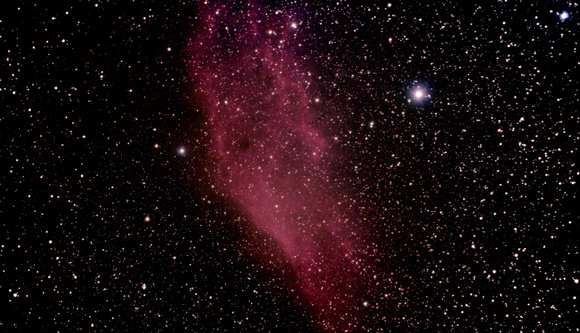Calforiia Nebula
Location: My POD in Tennessee
Photos: 600 sec x 6 ISO 1600
with darks,flats and bias subtracted
Camera: Canon XTi Unmodified
Scope: Meade 5000 80 ED f6 with .8 WO Field Reducer
Guiding : CGE 1100 using PhD with Shoestring Adapters
Processed withImage Plus
NGC 1499 (The California Nebula)
Distance: 1140 light Years
Right Ascension: 04 : 00.7 (hours : minutes)
Declination: +36 : 37 (degrees : minutes)
text copyright Robert Gendler
NGC 1499 is an extended emission cloud covering 1 by 4 degrees of sky located along the northern border of the Perseus OB2 stellar association. A large dark cloud (Lynds 1449) borders the nebula and extends for about 2 degrees north of it. These bright and dark clouds are part of a much larger molecular cloud complex that has various ionization fronts. We know the source of ionizing energy of the large cloud to be the star HD24760 or Epsilon Persei. This massive O type giant has the mass of 14 suns and a surface temperature of 27,600 degrees. It is located at the same distance as NGC1499 providing a safe assumption that its energy ionizes NGC1499. The problem is that the radial velocities of the NGC1499 and Epsilon Persei differ by as much as 65 kilometers per second. Most ionizing stars were born from the nebulae they illuminate but this is not the case with Epsilon Persei.
Epsilon Persei is a member of a class of stars called "runaway stars". They are usually O and B type giants that were ejected from their place of origin and travel through space interacting with various clouds they come into contact with. Epsilon Persei is believed to have its origins in the Perseus OB2 stellar association from where it became a runaway star some 400,000 years ago. It encountered the cloud we call NGC1499 as recently as 100,000 years ago. There are two competing theories that try to explain the phenomenon of runaway stars. One theory is that these stars were once the binary companion of a star that erupted as a supernova, sending its companion off into space at high velocity. The other theory is that close gravitational encounters during the early phase of cluster formation, when stellar number densities are high, can lead to ejections.


